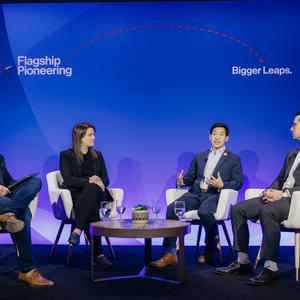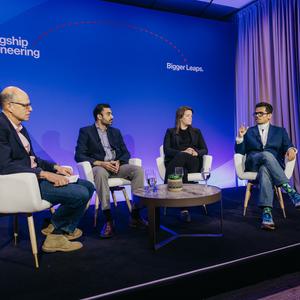Genetic discrimination, privacy concerns, psychosocial impacts, and misuse are just a few of the fears that bubbled up as the Human Genome Project (HGP) got underway in 1990. While optimists saw this ambitious scientific endeavor to decipher the entire human genetic code as a path to innovative therapies and healthcare transformation, others shared significant concerns, particularly related to ethical, social, and privacy issues. Decades later, the enormity of the impact that the HGP has had on advancing biology is clear, while the feared consequences have largely not come to fruition.
This mix of optimism and apprehension echoes the conversation around a scientific undertaking of today — the development, advancement, and application of artificial intelligence (AI). Like the HGP, visions for the future of this technology vacillate dramatically between utopia and dystopia, calling AI at times both a transformational tool and an imminent societal threat.
This disparate reception highlights not only the obvious uncertainty surrounding the impact of AI, but also critically how uncertainty is often conflated with risk. Flagship Founder and CEO Noubar Afeyan talks often of this distinction and wrote about it in his 2023 Annual Letter. He explained that risk is an estimable probability of future events, while uncertainty is an incalculable likelihood of future events occurring. As such, Noubar concluded that “the differences between risk and uncertainty are powerful, and powerfully important when it comes to scientific endeavors.”
In our scientific endeavors at Flagship, we do not run from uncertainty but rather run toward it, working to resolve the unknown to define a quantifiable, knowable, and manageable risk. From this position, we can benefit from privileged knowledge and contain risks that emerge. As such, we are rapidly and conscientiously pioneering the application of AI to biology because of the immense potential these twin engines have to propel us toward a healthier future.
As a co-founder and CEO of multiple Flagship-founded companies that integrate AI and biology, including Apriori Bio and Metaphore Biotechnologies, I maintain three principles I believe are critical to driving AI responsibly toward its promise: gather data to resolve uncertainty; integrate, don’t replace, biology with AI; and ensure multidisciplinary experts are at the table.
Gather data to resolve uncertainty
Back in the early 2000s, when I first started to apply neural networks to solve biological problems, our field assigned extreme risk to these projects because of their uncertainty, thinking they were unlikely to ever yield successful outcomes or drive our understanding of biology forward.
Today, we have swung in the opposite direction, and I would argue our field is now defining too low of a risk for AI projects in biology, eagerly pursuing AI as a solution to all of our problems, and AI critics are already proposing restrictions as if all projects will succeed. We should instead recognize the relatively high risk of projects failing to achieve its promises, because we don’t yet understand the many uncertainties. As such, we should avoid predetermined restrictions that hamper learning and progress toward unraveling the complexity and dynamism of biology using AI, which would otherwise be impossible to uncover in our lifetimes.
At Flagship, we are working to lower uncertainty and reassign risk by constantly applying AI to novel areas of application to unravel the interplay between biology, data, and AI, while building the infrastructure needed to leverage AI to its maximum potential. That broad application is critical to both pursuing our goals for expanding our understanding of biology, while learning of the perceived risks to society. We can see precedent for this in the HGP, as we saw the field uncover these concurrent lessons as the project progressed.
It is easy to see the potential for broad impact of AI in Apriori Bio. We are working to design new vaccines against current and potential future viral variants, as well as generating real-time, actionable insights into emerging variants to inform public-health decisions and policies. These two capabilities are integral to preempting and mitigating future viral outbreaks.
But this work would be nearly impossible without the application of AI. For example, if you look at the receptor binding domain of the SARS-CoV-2 Omicron variant, which is about 200 amino acids, introducing just 15 mutations or substitutions would generate >10^60 theoretical combinations of potential variants. This number is equivalent to the number of atoms in the universe, representing an impossible number of variants to experimentally test. But with Apriori’s proprietary AI-informed biology platform Octavia™, we can predict the most threatening viral variants from a near-infinite host of possibilities.
Integrate, don’t replace, biology with AI
Implementing computational approaches in the life sciences requires effective platform development that marries biology with computation. It is critical to continue to conduct biological experiments and generate empirical data as the foundation or validation of models. Experiments must be designed with guidance by data scientists, to ensure output from those experiments can be suitably and successfully integrated into models.
Implementing computational approaches in the life sciences requires effective platform development that marries biology with computation.
Apriori’s Octavia platform is designed from the bottom-up to seamlessly integrate experimental insights and AI. This is the same approach we use at Metaphore, which is developing novel therapeutics that mimic known targets or ligands but have optimized functions, specificities, and selectivities. Metaphore’s MIMIC™ platform identifies a pharmacophore (the set of essential features that elicit a highly specific function or action from another molecule) to mimic and then uses computational methods to finely map the surface features. Those features can then be adjusted via machine learning to optimize biological functions and resulting patient outcomes.
Empirical data is still foundational to the accuracy of the modeled molecular interactions. While most computer-assisted drug design models are based on static snapshots, the reality is that functional molecules are in constant motion. The Metaphore experimental platform considers the dynamics of the system, informing uniquely high-resolution maps of the pharmacophore. As a result, we have a better picture of the interaction and, thus, the steps necessary for optimization that will trigger a desired biological response.
Ensure multidisciplinary experts are at the table
While uncertainty swirls around the future impact of AI, the reality is that we can help to resolve some of that uncertainty and begin to manage potential risks through policymaking and industry best practices. I am again reminded of the HGP and the storm of anxiety it unleashed. Many of those feared outcomes were prevented by evolving rules to appropriately regulate genetic technologies and ensure the responsible use of genetic information without minimizing its potential impact.
Effective AI guidelines must be based on contributions from scientists and AI experts, as well as policymakers to ensure they are optimized for innovation and safety. Organizations like the World Economic Forum, which recognized Apriori as a 2023 Technology Pioneer, provide platforms for convening public and private sector leaders to address industry and societal concerns. As a computational scientist and life science leader, this platform allows me to add my perspective to multidisciplinary discussions, explaining how AI can help to accelerate and scale industry efforts to achieve societal goals, such as ensuring global health and well-being.
As we move forward in developing AI regulations, oversight should be based on a nuanced, balanced, and risk-based approach that carefully considers the needs of patients, as well as the appropriate and respective responsibilities of regulators and industry. Focusing on individual applications of AI can help to integrate the technology into existing regulatory regimes, while avoiding one-size-fits-all approaches that could limit innovation. This should be a collaborative effort between public and private entities.
Looking forward
AI is a powerful tool that can help us to break through the barriers of complexity and scale in biology, transforming how we develop vaccines and drugs in ways that will enhance safety, increase efficacy, and expedite patient access and impact. To realize this potential, we must align ourselves with shared strategic principles. By doing so, we can harness the full impact of AI to propel human health leaps forward in our lifetimes.






